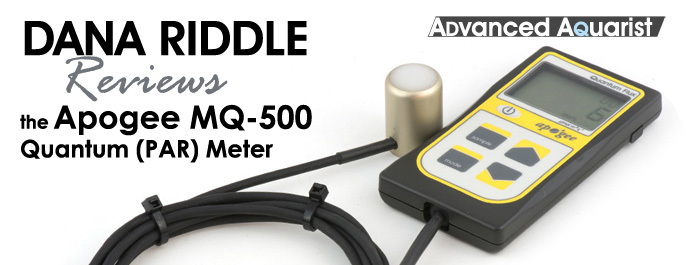
This month, we’ll take a close look at Apogee Instruments’ new MQ-500 quantum (PAR) meter and sensor with improved spectral response. The MQ-500 meter is a handheld device, with a water-proof sensor connected with a cable about 2 meters in length. It is battery operated and has data-logging capabilities. It is said to favorably compete with the more expensive PAR meters and sensors due to a ‘blue-enhanced silicon photodiode and custom optical filters’ within the light sensor. This sensor is advertised to better report light output from LEDs. Does it? Does it offer any advantages? To answer this question, we’ll pit the Apogee instrument against the gold standard of PAR meters – the Li-Cor LI-1400 meter and LI-192 sensor. And, finally, why should I own a quantum meter?
Late addendum to this article: I received word from Chris Madsen at Apogee designed a quantum meter especially for underwater use (that is, aquarium or aquaculture use). This device (dubbed the MQ-510) has the same features as the MQ-500 quantum meter. Its measurements of photosynthetic photon flux density are corrected for the immersion effect. It uses the same sensor tested in this article. See Figure 1.
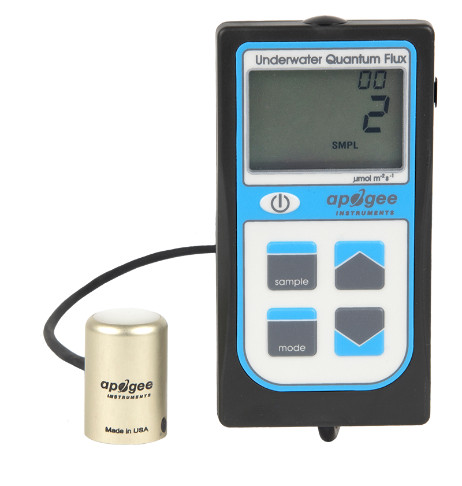
Figure 1. You heard it here first. Apogee Instruments’ new MQ-510 quantum meter. Its design and function have aquarists in mind.
Although I had been a marine aquarist since the 1960’s, my ‘scientific’ pilgrimage began in 1991 with the purchase of a quantum meter. It is believed that at the time I purchased the quantum meter from Li-Cor Biosciences, I was the only hobbyist to use such a device to measure light intensities within a captive reef (although a few were in the hands of professional aquarists such as Pete Mohan at SeaWorld Ohio).
The trend at that time was geared towards various (often pricey) gadgets and little attention was paid to measuring or monitoring light intensity, something that was said to be very important in the successful husbandry of many coral reef invertebrates. Yet, the amount of light was not quantified and was merely referred to as ‘low’ or ‘high’ intensities. It seemed that much work needed to be done in the lighting arena, so my attention turned to works published in scientific journals. References to light intensities reportedly received by corals, other photosynthetic invertebrates, and marine algae in these journal papers used terms I was quite unfamiliar with, such as photosynthetically active radiation (PAR) and photosynthetic photon flux density (PPFD), compensation & saturation points, and so on. This was in the days before effective search engines, and literature often had to be obtained through inter-library loan services or visits to university libraries. Through quite a bit of effort, a message emerged – understanding the lighting requirements of photosynthetic plants and animals would require a substantial investment in specialized equipment. To this end, I purchased the ‘quantum meter’ and submersible sensor from Li-Cor Environmental in Lincoln, Nebraska, USA to the tune of about $1,500.
Over the course of a few years, the price of quantum meters dropped substantially but these less expensive sensors were not as accurate as those meters costing 10x as much. Today, this situation has changed. Apogee Instruments’ recent introduction of their MQ-500 quantum meter with improved spectral response is the latest in a line of improved instruments.
Before continuing, perhaps it is best to familiarize ourselves with some of the technical jargon used in this and other articles.
Glossary
- Cosine Correction: allows a sensor to accurately measure light intensity even when the light source is not directly overhead. Apogee advertises their sensors will accurately (±5%) report radiation when the source is at an angle of 75% from the zenith. The quantum sensors discussed in this article can measure light within the 180° hemisphere above them, and are said to be “2 pi.”
- Nanometer (nm): One-billionth of a meter. Light wavelength (peak to peak) is reported in nanometers.
- Mole: A unit of measurement, for our purposes the number of light particles (photons) falling upon a surface. One mole = 6.0221*1023 photons, while a micromole is one-millionth of that amount. Fortunately, as aquarists, we don’t have to deal with these unwieldy numbers – we simply need to know that the maximum number of photons falling upon a given surface area (1 square meter) in a given amount of time (1 second) on a clear summer day at noon is about 2,100 micromoles and is reported as 2,100 µmol·m–²·sec-1.
- Photosynthetic Photon Flux Density (PPFD): The number of photons (as µmol) falling upon a given surface (one square meter) in a given amount of time (one second.)
- Photosynthetically Active Radiation: Visible light that promotes photosynthesis and has a bandwidth of 400 – 700 nanometers.
- Immersion Effect: In water, more light is reflected from the sensor (relative to a measurement made in air) and results in a loss of light hitting the detector. This is due to the different refractive indices of plastic, air and water. Expensive meters (such as Li-Cor) supply correction factors which can be programmed in to their meters, hence corrected measurements are automatically displayed on the meter readout. Apogee has taken a different approach and its latest version of software allows the user to toggle between ‘air’ and ‘underwater’ measurement. Interestingly, the immersion correction factor (1.32) for the Li-Cor sensor I own is the same as that of the ‘full-spectrum’ Apogee sensor – see below. For those using the Apogee ‘original’ sensor, the correction factor is 1.08. The reason for the different correction factors is due to the geometry of the sensors. Note that the new MQ-510’s readings are corrected for underwater use, and no further effort is needed.
- Spectral Response: Since PAR is that radiation between 400 and 700 nm, a quantum sensor should ideally report photons within that range. Since the energy of photons doesn’t matter in photosynthesis, we are interested only in the number of photons, hence an ideal spectral response should be flat. In other words, the sensor should be equally sensitive to photons independent of how much energy they have. As Figure 2 shows, Apogee’s ‘full-spectrum’ sensor has improved response in the violet/blue and red portions of the spectrum as compared to their ‘original’ sensor.
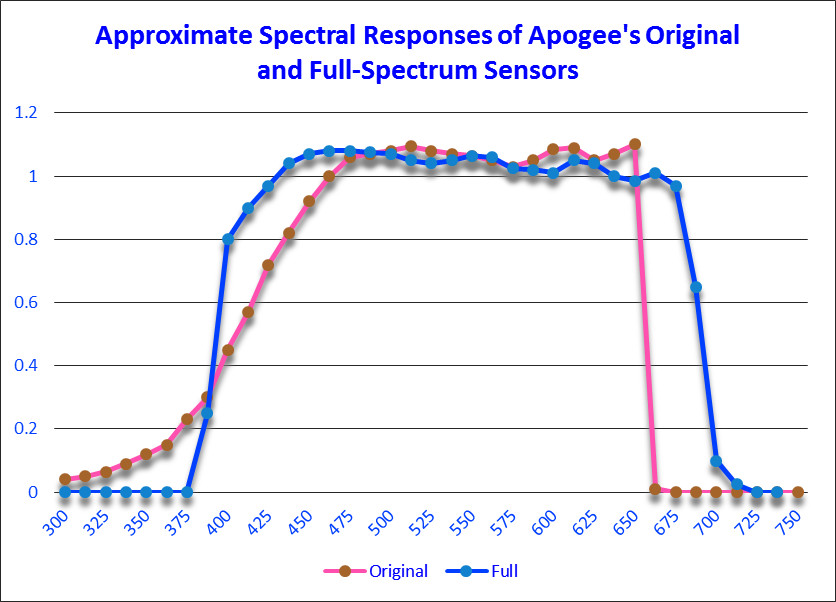
Figure 2. The new Apogee sensor offers an improved spectral response (orange line) over the original sensor (green line.)
Light Intensity and Its Effects on Photosynthesis
Books have been devoted to this subject but we’ll briefly review terminology used by botanists, phycologists (scientists studying plants, algae and photosynthesis) and coral reef biologists. Photosynthetic organisms require a minimum amount of light. When the amount of light causes photosynthesis to produce the amount of oxygen required to meet the organism’s respiratory rate, then the compensation point has been reached. Lighting should, at a very minimum, meet the compensation point. Compensation Points vary, but it is generally agreed that light intensity should not drop below 100 µmol·m–²·sec-1in any non-shaded area in a reef aquarium. After the compensation point has been met, the rate of photosynthesis will be proportional to the amount of light, but only up to a point. When increased lighting does not increase the rate of photosynthesis, the saturation point has been achieved. Generally, light intensities of 200 – 400 µmol·m–²·sec-1are acceptable and will produce high rates of photosynthesis (as well as triggering desirable reflective and fluorescent colors in corals). Exceeding the saturation point wastes expensive energy and could over-heat an aquarium. Greatly exceeding the saturation point could be harmful but natural mechanisms are in place. The ‘pressure-relief’ valves of photosynthesis are called xanthophyll cycles, where excess energy can be shunted away from the photosynthetic apparatus in a process called dynamic photoinhibition. If the abilities of these xanthophyll cycles are not sufficiently protective, chronic inhibition occurs. Chronic photoinhibition can reduce the rates of photosynthesis and, if allowed to continue, can cause permanent damage to the coral host and photosynthetic symbionts. In extreme cases, over-lighting can cause a great reduction (or almost total loss) of either photopigments found in zooxanthellae (such as chlorophylls a & c2, peridinin, etc.) or expulsion of zooxanthellae (in a process called bleaching). Bleaching can result in death of the coral.
Specifications of Apogee Instruments’ MQ-500 Quantum Meter and Improved Sensor
Sensor Size: 22.5mm diameter by 35mm tall (0.886″ x 1.38″). Size matters! It is an important consideration when the purchase of a quantum meter is being contemplated since reef hobbyists are often working within a relatively small space filled with animals easily damaged by a bulky device. While this new sensor is slightly larger than the older Apogee sensor, it is much smaller than Li-Cor’s. See Figure 3.

Figure 3. The Apogee sensor on the left; Li-Cor’s to the right. The Apogee sensor is obviously much more suited for use in small areas such as home aquaria.
- Photo-detector: Blue-enhanced silicon photodiode with custom optical filters.
- Spectral Range: 389 nm to 692 nm (wavelengths where response is greater than 50%). Apogee’s original sensor has a spectral range of 410 to 655 nm.
- Measurement Range: 0 to 4,000 µmol·m–²·sec1. Maximum sunlight is about 2,100 µmol·m–²·sec-1.
- Sensor Construction: Anodized aluminum housing with cast acrylic hemispherical diffuser. Hemispherical diffusers are sometimes referred to as ‘self-cleaning.’ This shouldn’t be construed as meaning the sensor diffuser shouldn’t be kept clean, especially if immersed in water for an extended period. Any appreciable algal or biofilm overgrowths will negatively affect the light measurements.
- Meter Dimensions: 112mm long x 65mm wide x 14mm thick (4.4″ x 2.56″ x 0.55″).
- Cable Length (meter to sensor): 215cm (84.5″). Custom lengths are available at additional charge.
- LCD Screen (Diagonal measurement): ~2 inches (~51 mm).
- LCD Character Height: ½” (~13 mm).
- Battery and Battery Life: The battery is a button battery (CR2320) and its expected life depends upon how often the instrument is used for data logging and how long data is logged (its memory is volatile upon removal of the battery). It is not unreasonable to expect a battery’s life to be a matter of months.
- IP Rating: IP68. “IP” stands for Ingress Protection. This is followed by two numbers. The first to protection against ingress of solids objects and the second is the level of protection offered against water intrusion. The 6 means the instrument is totally protected against dust. The 8 means it is protected against water under pressure greater than 1 m depth. With this said, the handheld meter is not submersible (the sensor is, of course!)
- Data Logging: The MQ-500 can automatically record measurements. In ‘Log’ mode it will store a measurement every 30 seconds. After 30 minutes, the 60 measurements are averaged, deleted, and the cycle repeats itself. The meter can store up to 99 30-minute average measurements (49 hours). Programming is simple and accomplished with just a few keystrokes. Data can be downloaded from the meter to a computer using an optional communications cable (USB-Mini5B – see below) and exported to an Excel sheet for further processing, if so desired. Ninety-nine measurements made manually can be stored as well. Data transferred to a clipboard is CSV (comma separated value) format. Note that the 30 second measurements are not recorded and therefore downloading is not possible.
Software can be downloaded here: www.apogeeinstruments.com/downloads
This software is available for both PC and MAC versions at no additional charge.
See Figure 4 for an example of data obtained through the data-logging feature.
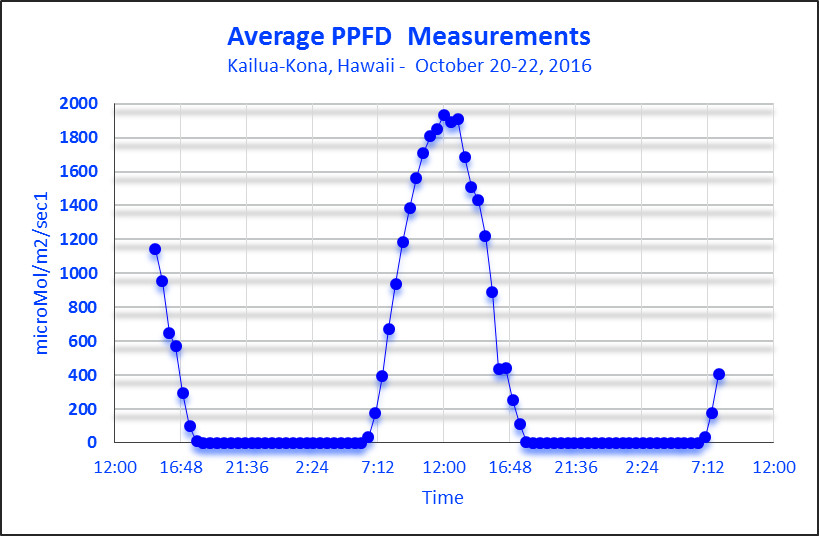
Figure 4. Light intensities over a two-day period as reported by the Apogee MQ-500. These are measurements made in air.
An interesting tool that data logging makes available is that of a summation of light falling upon a coral or another photosynthetic organism during the entire photoperiod. This is known as the Daily Light Integral or DLI. DLI is expressed as Moles Photons per Square Meter Per Day (mol photons·m²·day1.) The MQ-500 will perform this function. The best analogy I’ve heard is that which compares light particles (photons) to rainfall. While knowing instantaneous PPFD can be of great value it is comparable to counting the number of raindrops per square meter per second. The concept of the total number of raindrops (inches per day) is what DLI describes for photons. See here for details of DLI for Hawaiian corals: http://www.advancedaquarist.com/2013/12/lighting
- Miscellaneous Features: The meter’s LCD display has a Low Battery Indicator. The meter goes into Auto-Shutdown after two minutes of inactivity.
- Options: Apogee Instruments offers an optional wand to which the light sensor can be temporarily affixed (or permanently connected if one so desires.) This handy gadget keeps hands out of the aquarium water and allows sensor placement in tight spots. The wand price is $55.00 US. The AC-100 Communication Cable (USB-Mini5B) is required to download stored data. The cable has special circuitry which allows a computer to talk to the meter, Apogee can supply one for $55.00 US.
- Software: Software for a PC or MAC can be downloaded from Apogee’s website at no charge. Data is easily exported to an Excel spreadsheet for post analyses.
- Warranty: Apogee offers a four-year warranty on its products. Apogee recommends the sensor should be re-calibrated every two years and this is not covered by the guarantee. Current recalibration price is $50 US. Apogee offers an easy way to check meter calibration, and it can be found here: http://www.apogeeinstruments.com/when-to-recalibrate-clear-sky-calculator/
- Price: The price for the MQ-500 at the time of this writing is $495.00 US, plus shipping and any applicable taxes. We can expect the MQ-510 to be comparably priced. If price is an issue, consider the SQ-520 USB full-spectrum quantum sensor. This sensor plugs into a USB port of a computer or tablet with a Windows operating system. This software allows toggling between ‘water’ or ‘air’ calibrations and can store up to 10,000 measurements (that can be downloaded as a CSV file and exported to an Excel worksheet.) Real-time PPFD measurements can be viewed on a computer screen. Price for this sensor is $345.00 plus shipping and any applicable taxes. See here for further details: http://www.apogeeinstruments.com/sq-520-full-spectrum-smart-quantum-sensor-usb/
Conclusions and Discussion
It is well established that proper lighting is very important in the husbandry of aquatic photosynthetic organisms (corals, Tridacna clams, plants and algae). Too much lighting is wasteful and expensive, and it might tend to overheat smaller aquaria resulting in the use of a chiller or another water-cooling device. Too much light can also trigger dynamic photoinhibition (through conversions of a number photosynthetic pressure-relief valves involving xanthophylls). Worse, continued use of excessive lighting can cause chronic photoinhibition, where host and symbionts expend energy towards repair of photo-damage instead of other things such as growth or reproduction. In worst cases, photosymbionts such as zooxanthellae and zooxchlorae are killed, or expelled by their hosts in a process known as bleaching.
On the other hand, under-lighting will force the host/symbiont to consume energy reserves until they are completely expended. In this extreme case, due to extremely low photosynthetic rates, the animal will perish unless feeding (heterotrophy) can make up for the losses. Bear in mind, that increased feeding could result in detrimental water quality issues.
Many hobbyists obsess over calcium, magnesium, or other chemical concentrations, perhaps because the recommended values are well-established and are inexpensive to monitor. Lighting, on the other hand, is a more complex subject. In addition, it requires an investment in a PAR meter. But these facts should not discount the importance of knowing how intense the light fields are within your aquarium.
Apogee claims its full spectrum sensor can accurately determine the output of light-emitting diodes (LEDs) that generally have narrow spectral bandwidths. I tested several light sources and compared the results obtained with Apogee and LICOR sensors (in air). Note that measuring the intensity of a single point-source LED can be tricky (aquarium LED fixtures use multiple LEDs unlike most of the LEDs tested below.) I built a jig to hold the sensors and exercised reasonable care in making these comparisons, however, the measurements would likely have been a little closer if I had used an integrating sphere. With that said, there are the results:
| Light Source | Apogee | Li-Cor (rounded) |
|---|---|---|
| Sunlight | 2016 | 2005 |
| Blue/White LED Combo | 60 | 60 |
| Feit Blue | 48 | 47 |
| Ultra-Blue | 22 | 18 |
| Dark Blue | 18 | 15 |
| Dark Blue | 18 | 15 |
| Deep Blue | 20 | 18 |
| Blue | 28 | 27 |
| Light Blue | 32 | 28 |
| Sky Blue | 27 | 23 |
| Dark Green | 30 | 25 |
| Feit Green | 65 | 68 |
| Light Green | 27 | 22 |
| Yellow | 28 | 28 |
| Light Orange | 52 | 49 |
| Dark Orange | 36 | 34 |
| Orange-Red | 29 | 29 |
| Red | 33 | 31 |
| Purple | 29 | 25 |
| Pink | 46 | 46 |
| Underwater (blue LED) | 49 | 50 |
Details on the spectral characteristics of some of these lamps can be found here: http://www.advancedaquarist.com/2016/8/aafeature
As I have suggested, a PAR meter is a good investment for a hobbyist. If the purchase price is out of reach, perhaps your local aquarium club can purchase one and lend it to members.
I am impressed with the performance and price of the MQ-500 quantum meter. So much so, that I will regulate use of my Li-Cor LI-1400 quantum meter/ data logger and submersible sensor for low light work (such as moonlight) or very high light intensity (exceeding the Apogee’s maximum reporting of 4,000 µmol·m²·sec1. To the best of my recollection, there has been only one instance where I needed a meter that could measure higher than 4,000 µmol·m²·sec1 – this was in measuring the output of a Fusion sulfur lamp where the output could exceed Li-Cor’s maximum measurement of 20,000 µmol·m²·sec1).
In closing, I have listed below 11 Reasons to Own a PAR Meter:
- You Own a Reef Aquarium: Placement of photosynthetic organisms becomes critical. It should be understood that these organisms’ lighting requirements can differ drastically. For most corals, a range of 100 to about 300 micromoles should be sufficient. See here for some information on corals’ lighting requirements: http://www.advancedaquarist.com/2007/3/aafeature1 See comments on Tridacna clams below.
- You Use Fluorescent Lamps: Tubular fluorescent lamps produce the most amount of light at their centers. Generally, fluorescent lamps lose much of their output in 6 months or so.
- Monitor Lamp Intensity When Lamps Are Changed: Fluorescent lamps and metal halide lamps are notorious for losing intensity over relatively short periods of time. It is a good idea to raise the lighting luminaire containing new lamps to match existing light and then slowly (over a week or so) lower the lamps to raise intensity.
- Photosynthetic Animals Are Routinely Transferred Between Tanks: When I managed a commercial coral farm back in the 1990’s, we would often buy interesting coral colonies from local hobbyists. Our very successful transfer procedure was to match their new environment’s light field with that of the previous one.
- You Have a Freshwater Planted Aquarium: It is entirely possible to over-light a freshwater or saltwater planted aquarium. Aquatic plants are generally much less susceptible to ‘light shock’ hence the advantage of using a PAR meter would be in energy savings.
- You Use Metal Halide Lamps: Metal halide lamps contain an arc tube that acts as a point source of light. Even when efficient reflectors are used, significant light intensity gradients can exist over small distances. Metal halide lamps, especially those with high Kelvin ratings, lose intensity rather quickly (a matter of months).
- You Use LEDs (Light-emitting Diodes): It may come as a surprise that LEDs can generate too much light for some ‘light-loving’ photosynthetic animals and plants. More, some LEDs can be programmed to increase or decrease light intensity. Use of the data-logging feature can be used to calculate the total amount of light received by photosynthetic organisms. LED light output, in my experience, does not degrade as quickly as some other types of lighting do.
- You Propagate Corals: Coral farmers’ success depends upon the ability to grow their animals as quickly and efficiently as possible. Under-lighting can lead to poor growth rates and mortalities, while over-lighting can inhibit growth and needlessly waste expensive energy.
- You Keep Seahorses or Other Ambush Predators: As hobbyists we don’t often equate light intensity with feeding behaviors. It has been shown that feeding rates of ambush predators (such as seahorses) are proportional to light intensity.
- You Have Indoor House Plants (such as Orchids). Most of the advantages of using a PAR meter in aquaria would apply to house plants.
- You Maintain Tridacna clams. Most Tridacna species (maxima and squamosa, for example) are light hogs. See here for discussions on their lighting requirements: http://www.advancedaquarist.com/2007/3/aafeature1, http://www.advancedaquarist.com/2008/1/aafeature3
And finally, for insights on the types of zooxanthellae and their hosts, see here: http://www.advancedaquarist.com/2016/2/aafeature
Contact Information: Apogee Instruments, Inc. 721 West 1800 North, Logan, Utah 84321 USA Phone: (435) 792-4700 Fax: (435) 787-8268 Web: apogeeinstruments.com


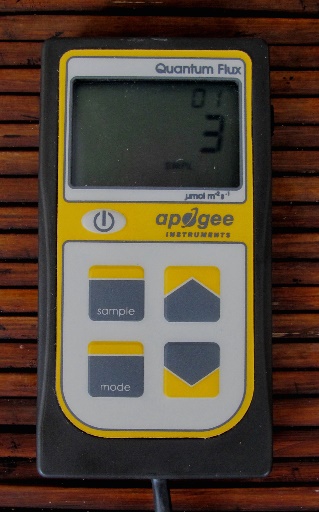

0 Comments